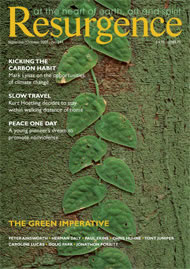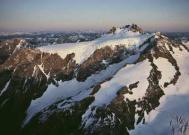CIRCLING HOME BEGAN as an offhand conversation over breakfast with a friend a few months ago. We were talking about global warming. What would it be like, I found myself musing, to spend an entire year within walking distance of home in the Pacific Northwest of America? What would it be like to spend a whole cycle of seasons in an intimate exploration of my home terrain, and to do so as a conscious response to global warming; not out of guilt, but as a positive affirmation, as a kind of pilgrimage into the heart of my own home region? Maybe what we need to learn more than anything else right now involves a radical turning back towards home?
It was a strangely energising thought, and I haven’t been able to let it go since.
It’s not as though the climate crisis is news to me. I have been concerned about it for years. But denial is a powerful force, even when we ‘know’ better. It’s amazing what we can refuse to see, when the act of seeing brings with it the necessity for change. Yet there is no denying that the tide of big change is now upon us. We either participate in these changes consciously, helping to guide their trajectory toward better options for our children, or we resist change, and relinquish our power to shape our own future.
So, I took an online ‘carbon footprint’ survey. I thought I would do relatively well. After all, I drive a hybrid car. I live in a modest-sized house. I recycle. I think of myself as careful in my use of energy. But I was shocked to discover that my personal carbon footprint is more than double the national average, and five times that of the average European. How could this be?
The answer was revealing. In my work as a meditation teacher, I travel a lot every year to teach. This is a privilege, and not one I take lightly. A single cross-country flight uses my personal quota for carbon emissions for an entire year. When I removed that single factor from the formula, my carbon footprint shrank to well below average, where I had hoped it would be. This was yet another wake-up call – that I need to rethink my working patterns and priorities.
SO, ONE MORNING I pulled out some maps of my region and started drawing concentric circles around my home in the Maxwelton Valley of Whidbey Island, to see what the different circles contained. At a radius of about 60 miles (100 km) I made an amazing discovery. The circle passes directly over the summit of Mt. Olympus to the west, the highest point in the Olympic Mountains. It passes directly over the summit of Mt. Baker, the highest point in the North Cascades. It passes directly over the summit of Glacier Peak to the east, the highest point in the Central Cascades. It just catches the San Juan Islands at the north end of the Puget Sound basin, then swings around to touch the southernmost tip of the Sound.
To my amazement, I discovered that my home on Whidbey Island is at a kind of symbolic epicentre of the Puget Sound basin. Inside this 100-kilometre circle lies 12,000 square miles of rich geographical terrain, abundantly endowed with places of power and beauty, most of which I have never explored. What would happen if I made my work for a year the intimate exploration of my own home region by foot, bicycle and kayak?
It has actually been a secret fantasy of mine for years to do something of this order. There are many practical benefits that come to mind. I am blessed with deep roots in the
Pacific Northwest, and there is nowhere else I would rather be. I love the
familiar mountains and forests and rain-drenched ecologies. Most of my extended family lives close at hand. I am richly endowed with friends and community right where I live.
There are other reasons to pull the circle inward too. I am a Zen student and a contemplative. I’ve often noticed that my capacity to access the depth and spaciousness of the world is in inverse proportion to the speed and distance I am travelling. During intensive meditation retreats, for example, my experience is usually the opposite of confinement. After some days dwelling in stillness and silence, I invariably notice an expansion of awareness both inside and outside of my body. Thoughts settle and loosen their grip. My ability to delight in simple things intensifies – the taste of good food, a walk in the woods, even the bare act of watching my own breath becomes amplified and enlivened.
The same dynamic holds true of my outward experience in the natural world. During the weeks I spend every summer guiding contemplative kayak trips in the Tebenkof Bay Wilderness of Southeast Alaska, I never venture more than a few miles from base camp, and never faster than the pace of the paddle. Yet my predominant experience is not of confinement, but of expansiveness. A stretch of wild coastline that I might barely notice from a jet plane at 30,000 feet becomes the embodiment of immensity, and a source of boundless exploration. The very act of slowing down and returning to a more human scale naturally opens my senses to the depth and beauty of the world.
So the question naturally arises, “How can I build this same sensibility into the rest of my life, making the place I live my ‘monastery’, my place of practice?” The answers that emerge from this inquiry may have surprising bearing on the question, “What are the solutions to global warming?”
In the conclusion of his Four Quartets, T. S. Eliot wrote:
We shall not cease from exploration And the end of all our exploring Will be to arrive where we started And know the place for the first time.
THUS MY VOW for the coming year will be “to arrive where I started and know the place for the first time”. I make this vow out of allegiance to my unborn grandchildren, but also with my own self-interest in mind. I know from experience that the invitation to wake up to what is near at hand always turns out to be a gateway to a feast.
Beginning with winter solstice in 2007, I will embark on a year-long project to see what I have been missing right under my feet. I will not get in a car during the year, relying instead on public transport, walking, biking and paddling to explore in widening circles the natural and cultural geography of my home region. I will write about what I discover, talk with the people I meet about where they find hope and belonging in this perilous time, and reclaim in fresh ways my relationship with the place that gave me birth.
Fifteen thousand years ago the Vashon Ice Sheet advanced down out of present-day Canada to reach its southern terminus in Washington State. The place where I now live was covered by 3,000 feet of ice. When the glacier retreated it left deeply cut valleys scoured from the earth. A new inland sea swept into those valleys. I grew up by the shores of this sea, surrounded by mountains. I live in the centre of it now. It remains one of the most beautiful things I have ever seen.
In a flash of geologic time, we humans have become the drivers of climate itself. Who could have imagined? As a species, we have pointed the Earth towards the opposite climatic extremes, with the throttle all the way to the floor. The last time the Earth was as warm as it is projected to be by the end of this century was 20 million years ago, and crocodiles lived in Antarctica.
This is not the world I want to bequeath to my grandchildren. I don’t want to wait until Antarctica is hospitable to crocodiles before I decide it is time to change.
My prayer is that these humble efforts during the coming year will link up with thousands of other creative responses to our climate crisis to begin a great turning back towards sane living in the only home we will ever have. May we face this crisis together with the audacity and creative flair that are our birthright as human beings.







